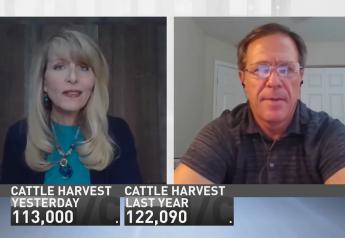Six Questions One Industry Veterinarian Says She Is Asked Most Often About HPAI

The emerging issue of Highly Pathogenic H5N1 Avian Influenza (HPAI) in the U.S. dairy industry changes on nearly a daily basis.
Novonesis (a merger of Chr. Hansen and Novozymes) hosted a webinar on the issue on Friday to update producers, veterinarians and other members of the agricultural community.
“It’s a rapidly evolving situation,” lead presenter, Kay Russo, DVM, Novonesis technical services manager for dairy and poultry, North America, stressed at the beginning of the program.
“I'm getting a lot of questions, and I'm sure everybody on this call has questions. Or if you're a veterinarian, you're receiving them,” she said. “Again, this is a rapidly evolving situation, and what may seem correct today may be different tomorrow.”
Here are the six questions Russo said she is most frequently asked, and what her answers to them are – for now. Russo’s answers have been lightly edited for clarity.
Question #1: Is HNAI spreading from cow to cow?
Answer: Initially the thought was that every one of these animals was exposed to the disease from a bird. But at this point, there is some consideration for the fact that this may be spreading laterally. How it's spreading is still unclear. There is some postulation that the virus is being spread in the milking parlor. Could it potentially be a mechanical spread from cow to cow on the milkers' hands, or perhaps (on) the milking machines? Is it possible in these parlors where the humidity is high, it's a warm environment that we're seeing some aerosolization of the virus, so I would say that's possible too. But there's more work that needs to be done. But for all intents and purposes at this time, I would suspect there is some lateral transmission.
Question #2: Why are calves, younger lactation cows and the feedlot cattle not getting sick?
Answer: Ultimately, I don't know the answer to this. More work needs to be done. The question needs to be answered. Are they truly not getting infected with a virus? Are they resistant to it, perhaps? Or is it that they are getting infected and just not demonstrating the clinical signs? We milk a lot of these dairy cows three times a day, so there's a lot of eyes on them. In some of these instances, with the calves or in the feedlot cattle, you're not handling them as often. We need to rely on the science to answer these questions in order to provide guidelines. I keep saying this, and I will continue to say it, we do not know what we do not measure. And we cannot provide guidelines around what we do not know.
Question #3: Is this a risk to humans?
Answer: The short answer is that it can infect humans. I know that in New Mexico, they are offering free testing to individuals that are working regularly with these infected herds. And if they are symptomatic – we're seeing conjunctivitis and high fevers in some of them –they are being distributed Tamiflu for their use and for their families. This is a rapidly evolving situation, and the people that are working on it are doing everything they can to ensure the safety of those individuals that are most at risk.
Question #4: Is milk safe?
Answer: The FDA has stated the pasteurization process should kill the virus, and we should not see it in any saleable milk.
Question #5: Will this be a market limiting disease outbreak?
Answer: This is the major concern here, folks. These are important markets for us in this country. At this point, this is something that is absolutely a consideration. The goal here is to keep the farms in business.
Question #6: Are dairy farms a risk to poultry operations?
Answer: We've seen two commercial layer operations, one in West Texas and one in Michigan, be positive for highly pathogenic avian influenza this week. I know that there's considerable amounts of work behind the scenes to determine the origin of the virus that caused the outbreak in those situations. Ultimately, in this circumstance, it's going to be important that the cattle folks and the poultry folks come to the same table and talk and manage through this. We want to be good neighbors. These are two major industries in our country, so it's important that the dialogue is there and continues so that we can keep (everyone) safe.
Texas-Sized Problems Hit the Lone Star State, but Ag Commissioner says ‘Things are Getting Better’
New Regulation: Dairy Cattle Entry into Nebraska Now Requires Permit Amid HPAI Bird Flu Concerns
Mexico Taking 'Preventative Measures' After Bird Flu Found in U.S.







